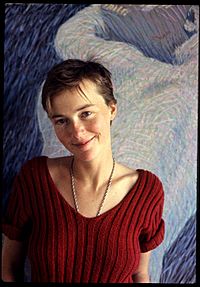Char Davies facts for kids
Quick facts for kids
Char Davies
|
|
|---|---|
 |
|
| Born |
Charlotte Adèle Davies
1954 Toronto, Ontario, Canada
|
| Education | Bennington College, 1973-1975 University of Victoria, BFA, 1978 |
|
Notable work
|
Osmose, 1995 Éphémère, 1998 |
| Style | Immersive Virtual Reality |
Char Davies (born 1954) is a Canadian artist. She is famous for making amazing virtual reality (VR) artworks. These artworks let you feel like you are really inside them.
Char Davies helped start a company called Softimage, Co. She is seen as a top expert in virtual reality. She also helped create a special kind of VR called bio-feedback VR. This type of VR uses your body's signals to control what happens. Davies lives in rural Quebec and San Francisco.
Contents
Early Life and Learning
Char Davies was born in Toronto, Ontario, Canada. She went to Bennington College in Vermont from 1973 to 1975. There, she studied many subjects like philosophy and biology.
Later, she moved to the University of Victoria (UVic). She earned a degree in Fine Arts in 1978. After college, she painted pictures of loggers and trees. She saw how loggers, who loved nature, also destroyed it. This experience really shaped her future art.
In 2005, Davies earned a special doctorate degree. She wrote about the deep ideas behind her own art.
Her Art Career
First Digital Artworks
Char Davies started as a painter. So, her first tries with virtual art looked a lot like paintings. She created her own special symbols and beautiful designs. Even in the 1980s, Davies was looking into computers. She explored how to use them to make 3D virtual spaces. In 1983, she saw computer animations. She felt that computer art could help her make images that were beyond painting.
Her Interior Body Series (1990-1993) was a group of 3D computer images. These images showed new ways art could be seen in virtual space. The Interior Body Series was shown all over the world. It won an award called Ars Electronica Distinction in 1994.
Davies is also a scuba diver. Some of her underwater adventures have inspired her art. For example, she got ideas for her VR work Osmose from waiting to see sharks. While in the water, she felt like she could "slip into an altered state of consciousness."
Virtual Reality Artworks
Char Davies is one of the first artists to use virtual reality for art. In 1993, she started using VR to make art. Her goal was to make people think about how they see nature and "being." She wanted to show how we are connected to the world. Davies believes VR can help us "examine our perceptions of the world." It can also let people have deep, thoughtful experiences inside a virtual space.
VR also lets Davies expand what art can be. A flat painting can become a 3D space you can explore. This space can even react to you. The images in her VR worlds are not made in old ways. Instead, they are created using special computer rules called algorithms. Davies combines unique computer programs to make her work special. She also says that her art depends on the team who helps her create it. She stresses that her art is still connected to her painting roots, especially in how she uses color.
Davies created an amazing virtual world called Osmose in 1995. It mixed 3D pictures and sounds that moved around you. You could interact with it using your breath and balance. Osmose was first shown in Montreal in 1995. It was part of a big art event called International Symposium on Electronic Art.
Osmose made viewers (Davies calls them "immersants") think about space. It explored the fuzzy line between real life and virtual life. In Osmose, there was a 3D grid you could travel through. You could "visit" twelve different worlds. These worlds were based on ideas from nature. To enter Osmose, a person wore a special headset. Their breath was measured by motion sensors. The virtual world was created by a powerful computer.
Your breathing became the "engine" to move through the virtual world. Breathing out made you feel like you were sinking. Breathing in made you feel like you were floating up. Leaning gently changed your direction. Davies developed this way of moving to help people focus on "being in the world." She wanted them to feel present, not just "doing" things. Davies spent many years studying light and space before making Osmose. She had help from John Harrison, who built the VR system. Georges Mauro created the virtual objects. Davies said the whole creative process was about exploring and trying new things.
Ephémère came after Osmose in 1998. It built on the idea of a virtual world as art. It also added time elements, like day and night cycles. Davies describes both works as a way to "return." She means they help us temporarily let go of our usual ways of seeing things. This allows us to see ourselves and the world around us in a fresh way. In Ephémère, you can go inside objects and see them from the inside out. As you interact with the world, things happen. For example, gazing at seeds makes them grow.
Making Software
Davies was a founding director of Softimage. This company made 3D computer graphics software. She was its first vice-president from 1988 to 1994. She also directed visual research from 1994 to 1997.
In 1998, she started her own company, Immersence, Inc. This company develops software to create 3D virtual environments. Immersence, Inc. also helps her continue her art research.
Awards and Recognition
In 2002, the University of Victoria gave Char Davies a special award. It was an Honorary Doctorate of Fine Arts. They gave it to her for her important work in media art.

